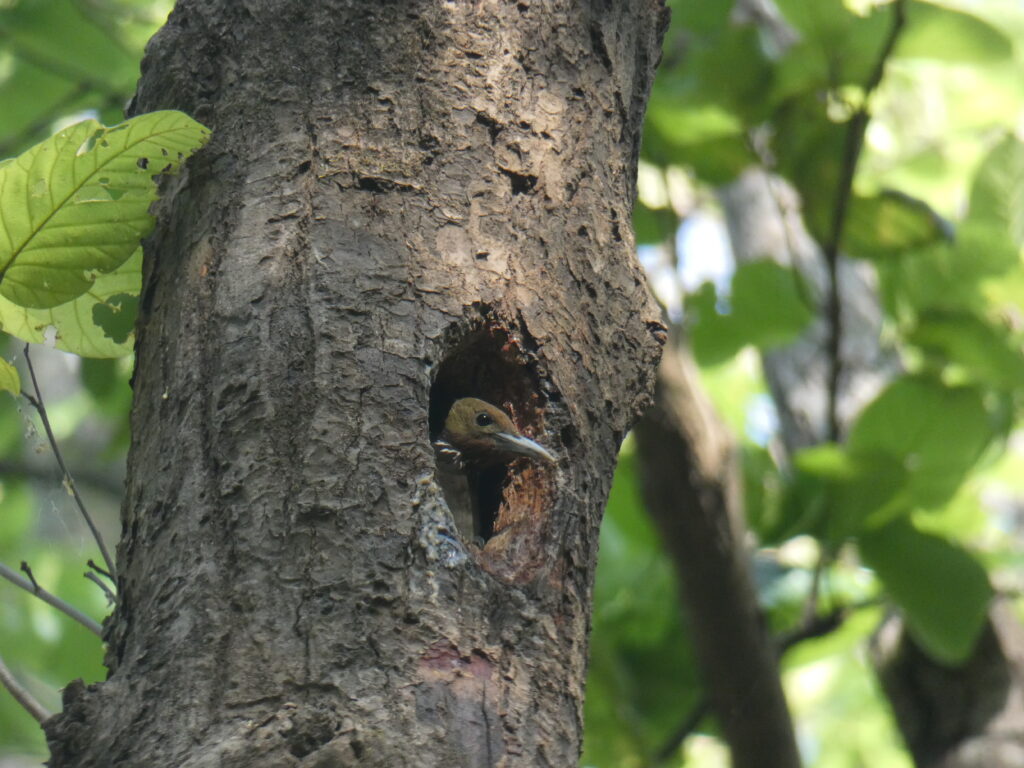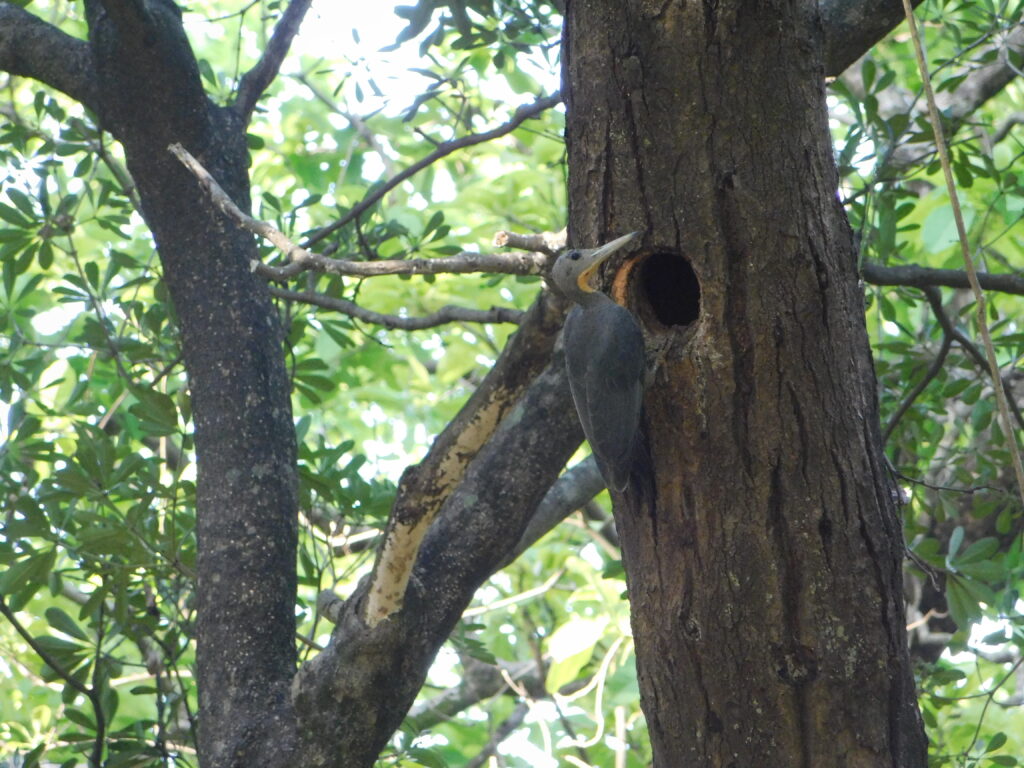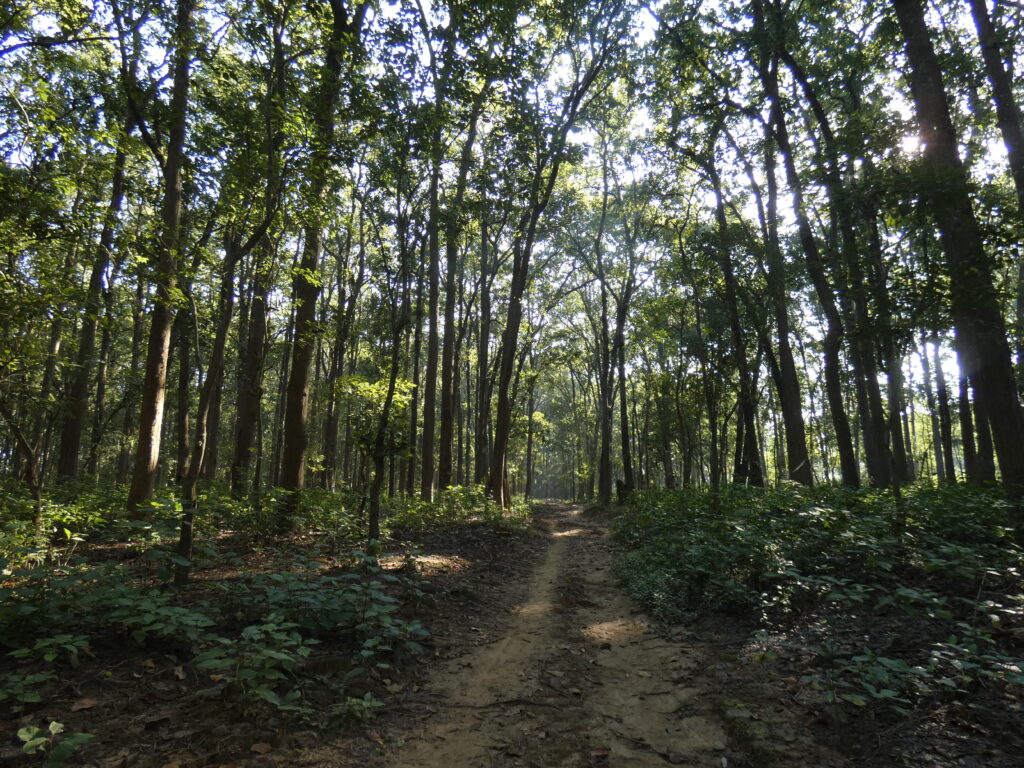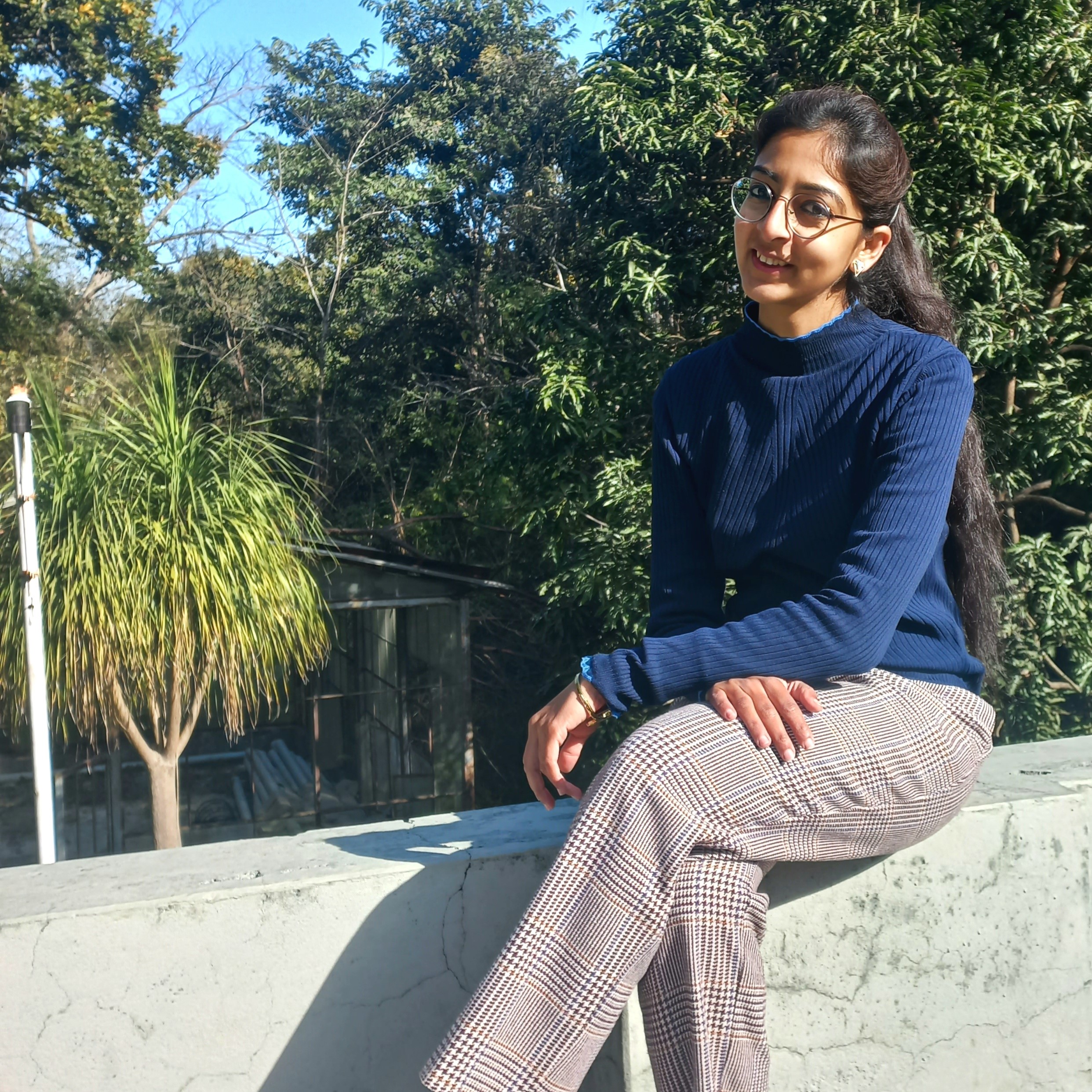There was a hint of cool which we knew would soon be overtaken by the heat of June. That morning, we were monitoring eight nests of five different woodpecker species in the forests of Pawalgarh and were desperately trying to find the nest of a particular family of the Great Slaty Woodpecker. This particular family was very elusive and always flew away when it sensed us. While we were busy looking for this family, we unexpectedly came across a nest of the Greater Yellownape Woodpecker. The nest had two chicks that were taking turns peeping out of the nest. Soon, the hungry chicks were fed a beakful of termites by their parents. It was truly a visual treat! However, we soon remembered that we should get back on our hunt for the elusive Great Slaty Woodpecker family and locate its nest. We knew it was time to leave the Greater Yellownapes alone. It did not take us very long to spot the family after we started looking for it again. We spotted two members of the family high up in a canopy of a Sal tree. In our earlier encounter with the group, we had noticed that a primary feather from the left wing of the male bird was missing. Using this as a clue, we were certain that it was the same family we were looking for. However, we had still not managed to make the family comfortable with our presence. Though we stopped at a distance to make sure we did not disturb them, they sensed our presence and chose to fly ahead to another tree, and again to another, and finally winged toward the direction of a river. We were not certain if they stayed at the edge of the ridge or crossed the river. Unfortunately, we had lost the family yet again. The family and the location of its nest still remained a mystery.
 A young juvenile of Greater Yellownape Woodpecker peeping out of the nesting cavity
A young juvenile of Greater Yellownape Woodpecker peeping out of the nesting cavity
This is how my interest in birds and nature took shape…
It was a feather! A simple question of who it may belong to steered me on a journey that now feels obvious. Since 7th grade, I have been irrevocably in love with feathers and birds. The first bird I identified without help was a Spotted Dove, and the first feather I collected for this bird was a semi-plume. However, before this accomplishment, I remember coining names for the birds and flocks that used to visit our home in the urban and commercial setting of Haldwani. This included regular visitors like three Blue Rock Pigeons whom I had named Otis, Sammy, and Sally, four Common Mynas named Littlefoot, Cera, Lucky, and Spike, a group of Brown Rock Chats that I called the ‘Echo’ group, Scaly-breasted Munia – the ‘Cute’ group, four House Sparrows, Black Kites, and Jungle Babblers. Sometimes I even saw flyover individuals of Red-vented Bulbuls, Black Drongos, and Indian Grey Hornbills, and even spotted the Black-hooded Oriole once! My most incredible recollection is from one winter morning in mid-December when I sighted the most brilliant colored individuals I had ever seen: a Rufous Treepie, Asian Green Bee-eaters, and Scarlet Minivets. However, I learned to identify birds only while I was doing my Master’s in Zoology (from The Dolphin Institute, Dehradun) with the help of my first field guide, “The Book of Indian Birds” by Salim Ali. Though I did not watch birds regularly, in my heart and mind, leafing through the pages of the book left an indelible memory of each bird.
Two reasons propelled my venture into research and the field of wildlife (and ornithology in particular). First, while growing up, I witnessed the disappearance of the birds I used to see regularly near my home. Second, one winter, when termites emerged from their nests, I observed how the bulbuls, thrushes, woodpeckers, babblers, crows, owls, and other raptors got together at a single spot to feast on the emerging termites. It was as if they had formed a unique foraging party for just one day. This observation later shaped my PhD study on the foraging behaviour of the Great Slaty Woodpeckers and sketched an image of them being the most docile and poised birds.
My journey in wildlife research commenced in 2017 with a strong inclination towards bird monitoring. My work took me to the landscape of Lansdowne Forest Division and the forests of Pawalgarh in the western Himalaya. In 2018, I entered the world of woodpeckers and undertook a study on the largest woodpecker in India – the Great Slaty Woodpecker in the small reserve of Pawalgarh. Before becoming a full-time PhD scholar at the Wildlife Institute of India, I had written to Dr. Martjan J. Lammertink, whose work on Great Slaty Woodpeckers from Southeast Asia was the only associated literature I had come across. I was lucky to get an opportunity to meet him in India in 2017 when he was delivering a talk on the woodpeckers organized by the Uttarakhand Forest Department. His positive response and support were the second step toward formulating my research; the first being the serendipitous moment of termite emergence. This observation associated me with the woodpeckers I had never dreamt of sighting otherwise and in my mind.
 An adult female Great Slaty Woodpecker perched outside her nesting cavity on a Sal tree
An adult female Great Slaty Woodpecker perched outside her nesting cavity on a Sal tree
I love what I do because..
Birdwatching is my daily passion. It’s a deeply ingrained habit, and I feel a profound connection with birds that has endowed me with unique and formidable qualities. I am drawn to the calls of birds and their presence, and in all honesty, it is difficult for me to express the yearning I feel when I hear a call that gets satisfied only after identifying it. For me, it has never been just about watching birds. I have always been involved in regular monitoring, and observing their behavior whenever possible. Indeed, it has been an integral part of my routine. I also thoroughly enjoy sharing the knowledge and stories I’ve gathered over the years with anyone who is driven by a passion for a deeper understanding of birds.
Challenges I faced..
The major setback I faced was raising funds for my proposed study, which significantly impacted my field surveys. During my fieldwork days, I also witnessed the illegal logging of a young teak plantation. We reported this to the forest guard and other officials. However, in this process, I ended up missing several field days during the peak breeding season of the Great Slaty Woodpecker due to threats from unethical yet powerful entities endangering the safety of our woodpecker team. I am grateful to have received strong support from both the forest department and my family. My parents carefully expressed their concerns and offered a solution in case a similar situation arose again. In another incident, while in the field, I once found myself face-to-face with a tiger! Luckily our team was able to avoid any ill-fated incident with no harm done on either side. On several occasions, encountering herds of elephants also posed challenges while collecting data on woodpeckers. Fortunately, with the support of my family, I was able to overcome these challenges and successfully conclude each survey.
 A Sal-dominated forest habitat of Pawalgarh Conservation Reserve – home to 19 woodpecker species
A Sal-dominated forest habitat of Pawalgarh Conservation Reserve – home to 19 woodpecker species
My advice to young researchers is..
I believe that commitment is the key. This discipline is driven by a combination of virtues: passion, dedication, patience, and understanding, which are all attained progressively. One needs to work consistently in developing these skills emphatically, engage with peers, and be vigilant about the technicalities. Watching birds is a simple yet fundamental activity that brings joy to some, peace to others, and to some it bridges the knowledge gap. If you find yourself inclined towards these winged beings, then allow yourself to step up with confidence and reverence, both to learn and to share your knowledge with others in your community. Citizen-based science has proven essential in effectively implementing conservation efforts, becoming a crucial monitoring tool for several bird species threatened by habitat loss. Your knowledge, combined with small yet meaningful actions, can help safeguard the integral connections we all share.
Sarabjeet Kaur, Ph.D.
Email: [email protected]
eBird Regional Reviewer (Dehradun and Nainital)
Research Gate
Instagram profile


I met the best girl in the world, you are unique and amazing, may all your dreams come true♥️🫡🫡🪬🪬
Thanks! In a way, I started my first birding outing with you. I am happy for that day when we sighted our first lifer White-crested Laughingthrush together 😉 And, we got stuck in quicksand/marsh afterward. What a day!